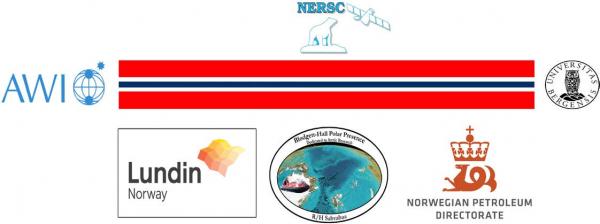
(16 - 30 March 2015)
Ice drift
The FRAM-2014/15 ice camp drifted 32 nautical miles (60 km) during the two weeks (Fig. 1). The ice motion was to the southeast and to the right of winds from the west-northwest during Monday 16th through Thursday 19th of March. The driving force was a region of high surface air pressure over the Canadian Arctic Islands. Then followed a period of southerly winds around the weekend and later winds from the north, but the ice drift was small. Wind speeds have been less than 10 knots during the whole period.
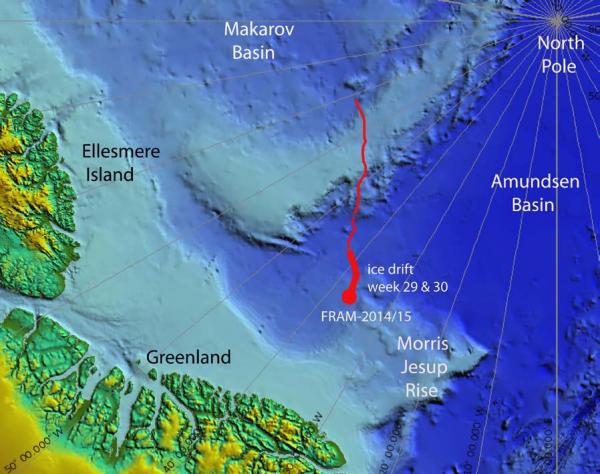
Fig. 1. The drift of FRAM-2014/15 during week 29 and 30; 16 - 30 March 2015 (heavy red line). Thin red line indicates start of 570 km long seismic transect from the Makarov Basin to the Morris Jesup Rise.
Sea ice dynamics
Week 29 ( 16-23 March) was calm, but severe ice activity started Monday 23 March and continued through the week. The camp site held since mid-December included an area of about 100 meter by 100 meter with distributed food, fuel, equipment and instruments. Half of this surface area was completely annihilated by a combination of one ice floe being thrust under the other and a pressure ridge formed. This includes the site where the hovercraft was parked and where most of the cargo was located.
Camp life
Air temperatures during the two weeks has been nearly constant (- 30° C to - 35° C ) except Monday and Tuesday 16 and 17 March (- 28° C). The first week was quiet and involved the daily routines keeping the seismic reflection measurements going and checking instruments. Preparations were made for an inevitable exit from this site at some unknown date. We cleared the snow around the hovercraft skirt as many times before and laid out anchor points for pulleys to be used to pull us out of the snow pit.
The wake-up call came at noon on Monday 23 March as a crack opened 3 meter to the side of the hovercraft and separated the tent from the craft (Fig. 2). The radiation flux instrument and the weather station were now on the opposite floe with the tent - the thermistor string was on a separate floe. By Wednesday this crack had become a 100 meter wide lead and we saw the tent in a distance. As soon as the crack opened water flooded part of the parking area and the skirt. The large accumulation of snow around the work space had loaded down the ice. The skirt in the water would quickly freeze in - 28° C and presented an imminent danger. We disconnected all cables and structures connected to the hovercraft and recovered the air gun. As we tried to move out, the engine would not reach high enough revolutions (pr. minute or rpm) to give us proper lift and help the winch pull us up the incline and out of the snow pit. After some time, we gained half a boat length, enough to get the skirt out of the water. However, we were not able to resolve the rpm problem and contacted Griffon Hoverworks, Southamton the next day. Here we got an immediate response from a team of engineers including expertise from Deutz, UK. We monitored the hovercraft engine performance using the diagnosis software and e-mailed screen shots to UK for scrutiny. From these, Deutz, UK engineer J. Thompson concluded that condensation in the air-cooler was the likely problem caused by hundreds of hours of idling at very low temperature. The big air-cooler was removed, taken inside and thawed (Fig. 3). Five liters of water was drained out. With this, the engine speed was back to normal. We now started to get the hovercraft up the incline and out of the snow pit, but overloaded the winch and later recognized that the damage to the winch was fatal.
We had another winch with only 40% of the capacity of the former. Audun arranged a series of pulleys which increased the theoretical pull by a factor of six, and we hauled the craft out of the snow pit (Fig. 4). Early Thursday morning the 100 meter wide lead started closing and ice rubble from the 15 cm thick, newly formed ice poured into the former work space and parking area (Fig. 4, lower left). We drove the hovercraft to a new site about 100 meters towards the middle of the floe. On Friday the two floes made contact. By Saturday, our floe had been thrust under the other, about 50 meter of ice consumed and a 3 meter high pressure ridge formed. Our entire camp site had been annihilated. We lost a few small equipment items and were able to pull two boxes with some food and the multi-fuel stove out of the front of the advancing pressure ridge (Fig. 4). There was a certain degree of disorder when the ice activity appeared to be over (Fig. 5)
The thermistor string had been separated from the camp area by a north-south trending lead and as it closed it also moved over 100 meter to the north. We searched for the string and recognized we would be only meters away from its likely position, but there was no sign of the mooring. This was a blow to our oceanography program. As you may recall, we also lost the acoustic Doppler current profiler during the ice activity in October.
We have just experienced an event in the life cycle of sea ice formation like. The impact on us is not so much being repeatedly shaken by unexpected developments and challenges to your ability to improvise and get out of difficult situations. The most significant impact relates to the state of mind and the struggle to maintain the motivation to face another start all over again for the fifth time in - 30° C and colder. The midnight sun is here by now, the white open landscape is beautiful and quiet - a harmonic dream scene, but you walk around with a feeling of being mentally burnt out. The job to get the camp back in order will take more than one week. We have left the Lomonosov Ridge, but still move over unexplored sea bed which represents a unique opportunity to get new data.
Safety
Contrary to the perception of many people, living on sea ice present no greater risk to life than walking the streets of any city unless you behave utterly stupid. It does represent a risk to immobile hardware placed on the ice. All relative ice movements are slow - less than 1 meter pr. minute. To the best of our knowledge, in the nearly eighty year history of ice drift stations no casualty has ever been related to ice floes breaking up or pressure ridge formation. The few lives lost, have all been related to helicopter and air craft operations. Formation of a crack or a pressure ridge is not an accident, but a natural process in the life cycle of sea ice formation. A crack is more or less harmless, but ice ridging is destructive and you will need to get any hardware out of the way. In the extreme case of loosing the hovercraft, we have tents, stoves, provisions and fuel to live comfortably on the ice for several months. It may be fortuitous, but it appears to us that if a lead widens to more than a few meters, a pressure ridge is likely to form when the floes come together again. Although our data base is meager, so far we consider the width of a lead to be an omen.
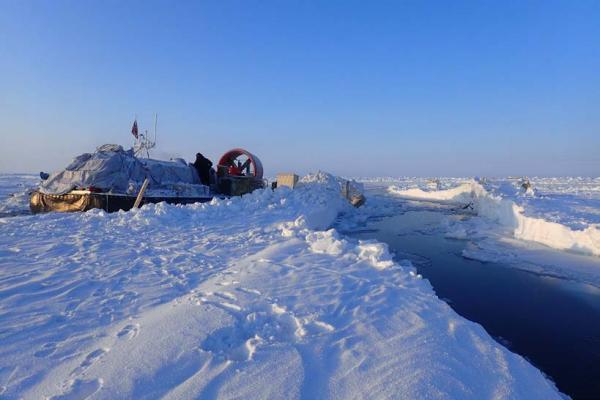
Fig. 2. Opening of the crack that separated the tent (buried on the right side) from the hovercraft.
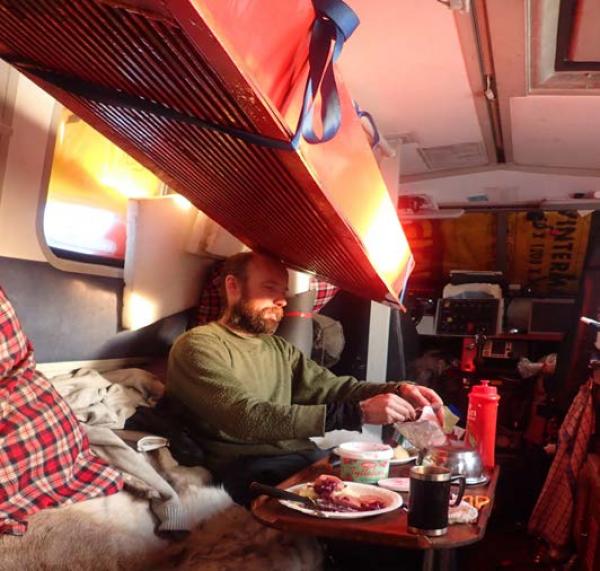
Fig. 3. Audun having dinner under the thawing intercooler suspended from the hand rail above.
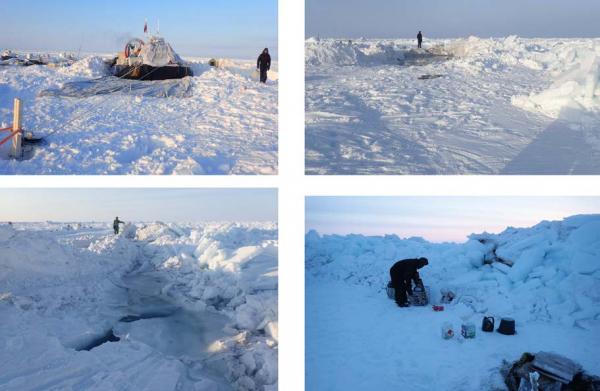
Fig. 4 Different phases of the destruction of the camp site.
Upper left: Ready to winch the hovercraft out of the snow pit Upper right: The abandoned parking place partly filled with water Lower left: The pressure ridge is moving in. Lower right: Audun is pulling out the multi-fuel stove from the front of the pressure ridge which by now had advanced 40 meter to the left of the parking area.
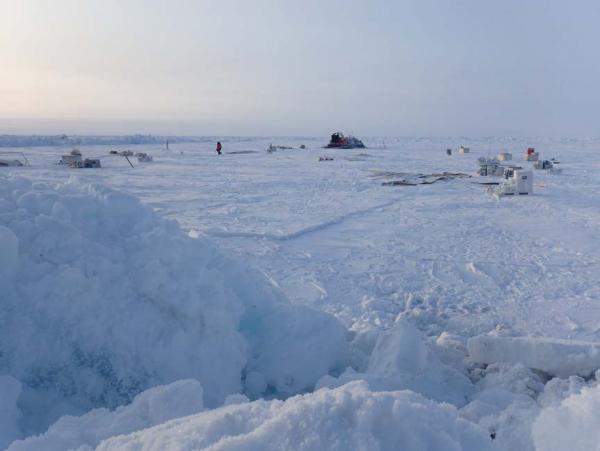
Fig. 5. Equipment and provisions having been moved away from the advancing pressure ridge
Science
Underway continuous measurements:
Bathymetry and sub-bottom profiling:
- 41 kilometer of continuous seismic reflection measurements (week 29 only)
- one autonomous echo sounder buoys reporting to shore via Iridium
Oceanography:
- two Aanderaa current meters at 800 and 2.000 meter depth, respectively.
- thermistor string lost
Atmosphere:
- measurement of incoming and outgoing radiation from the ice surface
- surface infrared skin temperature
- sun time
- Aanderaa weather station
Station work
None. The water depth is about 3.300 meter and beyond the length of our available kevlar line (2.800 meter).
The seismic data acquisition was going very well up until Monday 23 March when ice activity started. We passed the foot of Morris Jesup Rise, but the sediments were thick and we did not directly see basement reflections. During some time intervals we were bothered by unknown signals with amplitudes up to ten times the bottom reflection
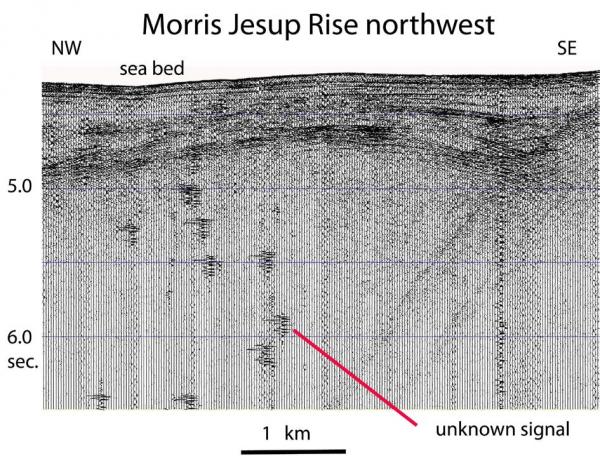
Fig. 6. Screen shot of the seismic monitor on approach to Morris Jesup Rise. Display with fixed gain.
The weather station and the radiation flux measurements were unaffected by the ice activity and was moved over to the new camp area. However, there is no power to the fan on radiation instrument for the time being.
Sea ice is rigid, brittle and move on a fluid, the ocean. These properties are often used as an analog to the behavior of outer part of the Earth. The outermost part of the Earth (the lithosphere is 10-150 km thick in the oceans) is cold, rigid, show brittle behavior and rests on the deeper part which is hot and able to flow on time scales of thousands of years - a phenomena much like glaciers flowing down the valleys on continents. The surface of the Earth is divided into plates which move relative to one another; new surface area is created by volcanism at mid-ocean ridges and destroyed by subduction in trenches. New ice is created by leads opening and freezing and destroyed by under-thrusting and deformation forming pressure ridges. What happened to us during week 30 was a text book example of just this process. We stood behind the pressure ridge to the left in Fig. 7 and heard the ice floe to the right being thrust underneath the ice floe behind the ridge. The difference between the Earth and the ice analog is that the under-thrusted ice is buoyant and follows the underside of the other floe, whereas in the Earth the plate goes down because it is cold and heavy and sinks under its own weight to deeper levels (Fig. 7).
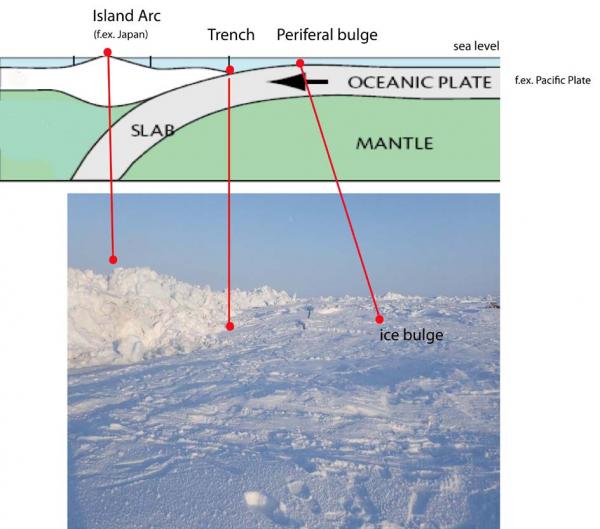
Fig. 7 The analogy between destruction of plates on the surface of the Earth and partial destruction of the sea ice cover.
Other
We are proud to acknowledge the decision of the Norwegian Petroleum Directorate to support the FRAM-2014/15 expedition with NOK. 1.5 mill. in 2015. This brings the total funds to cover the operational costs for a ten month ice drift to NOK. 4.6 mill.. Additional contributions in kind are by Blodgett-Hall Polar Presence LLC (hovercraft), A. Wegener Institute of Polar and Marine Research (deployment), and the 333 Sq. of the Norwegian Air Force (re-supply). We hope to be out of the ice in June.
There has been no sign of animal life in our neighborhood during the two weeks.
Despite the cold and the odd cases of ice activity, life in the High Arctic is treating us well.
Yngve Kristoffersen & Audun Tholfsen
Daily reports
Monday 16 March.
Position: 85° 42.6' N, 40° 40' W, temperature - 28° C, air pressure 1015 hPa, wind 7 knots from the W. Ice drift 0.2 knot to the E. Shooting seismic reflection all day. We are getting sporadic strong chirp signals disturbing our seismic records. Checked radiation flux instruments - cleaned IR sensor. The crack has closed with minor shear movement. Audun positioned an idling wheel in front of the hovercraft to prepare for pulling out of the snow pit. Spent the day cleaning snow around the hovercraft.
Tuesday 17 March.
Position: 85° 41.3' N, 40° 21' W, temperature -28° C, air pressure 1022 hPa, wind 3 knots from the W. Ice drift 0.1 knot towards SE. Shooting seismic reflection all day. Large lead opened about 500 meters away to the north of us.
Wednesday 18 March
Position: 85° 37.7' N, 39° 45' W, temperature - 36° C, air pressure 1039 hPa, wind 7 knot from the WSW. Ice drift 0.2 knots towards SE. Shooting seismic reflection all day.. Checked radiation flux instruments and weather station - cleaned IR sensor. Audun placed bathymetry buoy # 3 outside for testing with 12 volt supply.
Thursday 19 March
Position: 85° 34.4' N, 38° 51' W, temperature - 31° C, air pressure 1041 hPa, wind 10 knots from the W. Ice drift 0.2 knot to the SE. Beautiful day with clear sky and the sun. Shooting seismic reflection all day. Audun made a ski trip to search for bathymetry buoy # 4 and # 5 -located one, but was stopped by a wide lead about 4 km out from our camp. E-mail from the Norwegian Petroleum Directorate announcing their support for FRAM-2014/15 with NOK. 1.5 mill.
Friday 20 March
Position: 85° 32.6' N, 38° 16' W, temperature - 30° C, air pressure 1028 hPa, wind 6 knot from the NW. Ice drift 0.1 knot to the SE. The solar eclipse was hidden by clouds in the beginning and partly covered during the last phase. Shooting seismic reflection all day, but has to stop at 2300 hours due to leaking air gun. Audun changed memory card on the radiation flux instruments. Hauled buoy #2 and two 70 Ahr car batteries out to the buoy site 1.7 km out, but unable to connect up in the cold.
Saturday 21 March
Position: 85° 30.7' N, 38° 22' W, temperature - 35° C, air pressure 1027 hPa, wind 5 knots from the S. Ice drift 0.1 knot to the SE. Had 12 volt supply off from midnight to mid-day as part of checking why our power consumption is so high. The seismic data logging PC with its old battery was the problem - removed the battery and connected the power supply to a 12 volt battery on the engine side. Serviced the air gun and started shooting at 1400 hours. Changed battery on the radiation flux instrument data logger.
Sunday 22 March.
Position: 85° 28.4' N, 38° 15' W, temperature - 31° C, air pressure 1030 hPa, wind 2 knots from the N. Ice drift 0.15 knot towards S. Shooting seismic reflection all day. Checked the radiation flux instruments, cleaned IR sensor and removed snow from weather station.
Monday 23 March
Position: 85° 26.1' N, 38° 04' W, temperature - 34° C, air pressure 1034 hPa, wind 7 knots from the S. Ice drift 0.1 knot towards S. Shooting seismic reflection. The NE-SW running crack c. 50 behind the hovercraft that separated the thermistor string from the rest of the camp widened to c. 20 meter. A parallel crack 50 meter in front of the craft opened and became c. 2 meter wide. But at 1200 hours a new crack between the two cut 3 meter to the side of the hovercraft and separated the tent from the craft. About 20 cm of overwater flooded the ice. This represented an imminent danger as the skirt would freeze in and lock the hovercraft to the ice. We disconnected cables, recovered the air gun and took down the plywood structures that connected the tent to the hovercraft. We further laid out the 9 x 14 meter tarp in front of the hovercraft to prevent air leakage through the porous snow. We started the engine, but were unable to get the necessary speed for the craft to lift. For a short while we reached 1500 revolutions pr. minute (rpm) which gave sufficient lift to enable the winch to pull the craft half a boat length forward and out of the water. Tried a number of likely options (fuel filters. air filter, turbo, pipe connection to intercooler, rack on fuel pump) to solve the engine speed problem in consultation chief engineer H. Berge (retired) in Spain, but got no significant improvement.
Tuesday 24 March
Position: 85° 25.4' N, 37° 49' W, temperature - 31° C, air pressure 1028 hPa, wind 2 knots from the N. Ice drift 0.1 knot towards S. A beautiful day, no wind. We contacted Griffon Hoverworks, Southamton and got an immediate response from a team of engineers including expertise from Deutz, UK. We were able to monitor the hovercraft engine performance using the diagnosis software and e-mail screen shots to UK for scrutiny. From that Deutz, UK engineer J. Thompson concluded that condensation in the air-cooler was the likely problem caused by hundreds of hours of idling at very low temperature. The air-cooler was removed, taken inside and thawed. Five liters of water was drained out. With this, the engine speed was back to normal. We now started to get the hovercraft up the incline and out of the snow pit, but overloaded the winch and later recognized that the problem was fatal. A propeller air craft at low altitude was seen at 1300 GMT.
Wednesday 25 March
Position: 85° 25.3' N, 37° 26' W, temperature - 34° C, air pressure 1009 hPa, wind 1 knots from the N. Ice drift 0.1 knot towards S. Beautiful day, clear sky and calm. By now the lead next to the hovercraft had widened to about 100 meters. The ice activity was very low. Audun took apart the winch to attempt repair, but windings were cut and burnt - a fatal fault. We have another small winch with
only 40% of the capacity of the former. Audun devised a series of pulleys, one being the drum of the damaged winch. This scenario would in theory increase the maximum pull by a factor of six.
Thursday 26 March
Position: 85° 24.4' N, 37° 24' W, temperature - 34° C, air pressure 1011 hPa, wind 7 knots from the N. Ice drift 0.1 knot towards S. At 0230 hours, we suddenly woke up to the sound of ice ridging - the 100 meter wide lead next to the hovercraft was slowly closing. The 15 cm thick new ice on the lead was now piling up as rubble where the hydro hole was. We started winching while running the engine at maximum power and 50% forward thrust. The hovercraft came slowly up the incline out of the snow pit. The ice activity stopped in the early morning when the lead had narrowed down to 10 meter. We were very tired and went to bed at 0900 hours, still only 10 meter away from the lead. Got up after lunch and powered up the hovercraft at 1600 hours and drove off to a new camp site in the middle of the floe about 100 meter away. The tent which was at the edge of the lead on the other side was the next priority. It was buried in snow up to the roof and the floor was covered with 10 cm thick ice from frozen overwater. The drum with 2.800 meter Kevlar line and everything else were recovered.
Friday 27 March
Position: 85° 23.7' N, 37° 24' W, temperature - 31° C, air pressure 1015 hPa, wind 5 knots from the N. Ice drift 0.1 knot towards S. Worked all day clearing equipment and food away from the pressure ridge. The fuel was the first thing to be pumped over to an empty bladder 50 meter away. The radiation flux instrument and the weather station was dismantled at 2000 hours and carried over the pressure ridge to our floe. Intermittent ice ridging had by now consumed the site where the hovercraft had been parked for the last three months. The pressure ridge was 2 meter high and 10 meter wide. We have up until now not lost any food or equipment.
Saturday 28 March
Position: 85° 22.4' N, 37° 30' W, temperature - 32° C, air pressure 1015 hPa, wind 9 knots from the N. Ice drift 0.1 knot towards S. Woke up at 0530 hours to the sound of fierce ice ridging 100 meter away at the old parking site. To our surprise, the pressure ridge had increased to 3-4 meter high and advanced about 40 meter into our floe from the original crack where the hovercraft used to be parked. We were able to dig out two boxes of food and some equipment items. We then went to search for the thermistor string which had been isolated on another floe to the northwest. This separate lead had now closed with over 100 meter of transverse motion. We could find the approximate location of the mooring site within meters, but the site was buried under a pile of ice rubble and no traces of the mooring could be seen. We went to bed at 1000 hours and got up at 1500 hours. Audun checked out the mooring sites for the two current meters and they had not experienced any ice activity. We then started preparing a new parking area for the hovercraft by pouring water over the surface instead of having to put a tarp underneath to seal off the porous snow.
Sunday 29 March
Position: 85° 20.5' N, 37° 26' W, temperature - 32° C, air pressure 1021 hPa, wind 6 knots from the N. Ice drift 0.1 knot towards SE. Finished off preparing the parking area and pulled the craft on place resting on two 4" x 4" pieces of lumber. Moved some equipment items away from the pressure ridge towards the new camp site. Audun refueled the hovercraft.
